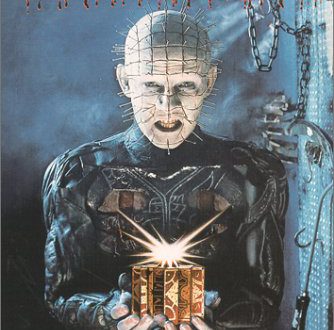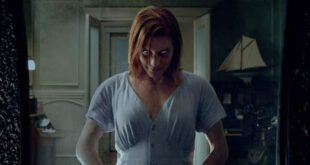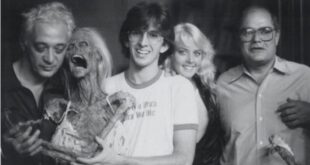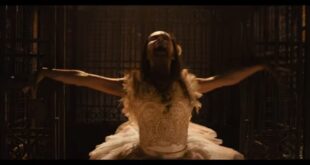HELLRAISER – ABOVE AND BEYOND THE LIMITATIONS OF HORROR
PopHorror is celebrating the 30th anniversary of Hellraiser, which debuted in theaters on September 18, 1987. This cult classic goes to the limits of horror and takes you beyond. The movie is unique within the genre, and the images are unlike anything anyone has seen.
At the age of 34, Clive Barker (Nightbreed 1990) made his feature film director debut. The movie was meant to make a great impact, as it dealt with the passion and perversity straight from his written fiction, The Hellbound Heart (see our literary review here). He was unique at the time, being both the writer and visual artist, which allowed him for a breadth and depth of understanding as to what was going on. He knew that viewers would either despise this movie or go out of their minds.
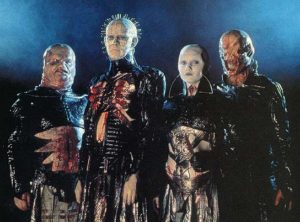
Hellraiser is a deep film. It has a lot of human interest in it, not only gore, and Clive knew exactly what vision he wanted to portray. He was more of a guide than a director, and because he had such great passion and vision, the cast and crew worked in complete unity with him. His motivations were real and solid. The story about a man who is obsessed with his sensual experiences and goes to great lengths to make a deal with dark forces leaves him with torturous results in the end. A personal hell of his own. The dark forces there are ageless experts in the art of refined pleasure, and even more refined pain.

Hellraiser stars Andrew Robinson (Dirty Harry 1971), Clare Higgins (Hellbound: Hellraiser II 1988) and Ashley Laurence (Hellbound: Hellraiser II 1988). The Cenobites – a word meaning “a member of a communal religious order” – are a must to mention, with Simon Bamford as Butterball, Doug Bradley as The Priest/Pinhead, Nicholas Vince as Chattering/Chatterer and Grace Kirby as The Female.
An extraordinarily disturbing and scary film, Hellraiser succeeded in disturbing its audience and continues to do so three decades later, capturing them in ways they didn’t expect. The intimacy, danger, rawness and ugliness is what they love, as well as the fact that it’s so grotesque yet beautiful. It shows that humans are flawed, and audiences can easily relate to the concept that humans are damaged, wounded and open.
Bob Keen’s team went beyond the stereotypical monsters of horror and aimed to create creatures resembling nothing that anyone had seen or experienced before. Hellraiser stunned us with its elegance and beauty, while being appalling us with its subject matter. There is, of course, a happy ending, albeit not one for everybody.

The first movie a filmmaker creates is successful by the luck of the draw. Clive collaborated with a few friends and decided to film the movie on the power of pure courage. Clive created about half a dozen drawings to give his crew a sense of what the movie would be like visually. The drawings were meant be repulsive yet glamorous, revealing characters that were meant to be butchers – magnificent, super butchers.
Of course, there’s a dash of Gothic style and S&M, completing the characters and making them more hellish than one can imagine. Clive drew inspiration for the Cenobite designs from punk fashion, Catholicism and his many visits to the S&M clubs in New York City and Amsterdam. They were mainly based on their appearances from the book.
The first Cenobite was Butterball, formally human, who had lost all memory of his life previous to his transformation. The second, The Priest (later to be known as Pinhead), was also formally human but had become one of the leaders of the Cenobites. The third, Chatterer, was given his name because clicking his teeth was his only means of communication. It is said that he was once a handsome young actor who specialized in off-color humor, and was hugely successful yet corrupt in all manner of things. He eventually encountered the box. It sensed his dark heart and mutilated his face to match his inner self. He was then brought into the Order of the Gash.

The fourth Cenobite was The Female, a former nun who was obsessed with sin and the origin of it – so obsessed that she willingly sacrificed herself to become a Cenobite. The Engineer was drastically altered for Hellraiser, taking the form of a giant creature with characteristics of various predatory animals. Regarding the dress code, the Cenobites all wear fetishist black leather clothing that resembles butchery garments or religious vestments. Their bodies are mutilated and some have body piercings.
The Cenobite’s origins and motivations are rather ambiguous, despite the presence of the word “Hell” in the franchise. The initial entries in the series – The Hellbound Heart and Hellraiser – refrain from any overt reference or iconography linking the Cenobites to traditional Abrahamic or Eastern depiction of damnation, demonic nature, or infernal origin. The Cenobites’ form of pleasure and the realm in which they practice it is simply so awful that it appears to be Hell to those unable to endure it. The Demons, as they are called by those who encounter them, are also known to some as Angels, but they see themselves as explorers. They are wholly unethical and prioritize in what is right or wrong in accordance to their lifestyles.
Hedonism, a form of religious and supernatural devotion in its earliest incarnations, is a manifestation through the expansion of sensation to an extremely painful point of sensory overload. This was the Cenobite Practice. Many monks practice this form of unnatural Asceticism, which is defined as a practice involving body modification and the self-infliction of pain. For some, pain equals pleasure.
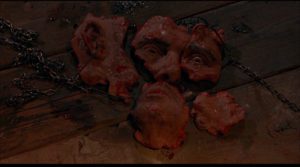
For the Cenobites, their only access to Earth is through the ornately designed puzzle box created by Philip Lemarchand called the Lament Configuration, which opens a dimensional schism. The leader, known as The Engineer, oversees the Order and the transformation of individuals into Cenobites. Their presence is occasionally preceded by a messenger, known as the Puzzle Guardian, who mostly takes the form of a vagrant offering specific individuals the gilded puzzle box. He informs his customers that the box has always been theirs, and that they were preordained to encounter the Cenobites.
The Cenobites reside in a monastery in Hell, which is governed by an Abbot. In order for them to conduct their business of harvesting human souls, they require their subjects to obtain the Lament Configuration and open it, enabling them to be transported. Once the puzzle has been solved, you can hear the large monastery bell tolling.
For the scenes of the resurrection of Frank, they had rigs to move the floorboards and lift the nails up. Ooze was used to pump upward into the floorboards and a lot of reverse photography was used where they destroyed the ribcage. Springs were used to pull out and shoot it backwards to see the destruction of the torso. Each time doing another take and aiming for another texture. Everything creating a masterpiece of resurrection.
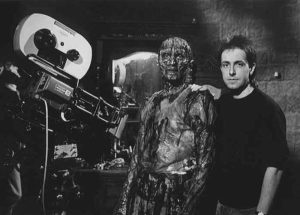
Ashley Laurence was cast in the role of Kirsty, where she found a creative cohesion, good atmosphere and understanding while working with Clive. The next casting was for The Priest, and that’s where Doug comes in. Hellraiser was his first movie, so it seemed logical that he be recognizable on screen. Alterations were made to make him recognizable as The Priest/Pinhead. This unusual new character filled a void in horror, and of course, Clive nailed it – no pun intended. In regards to Pinhead, you get the sense that he’s a man of the world and has seen and done everything, but has now become bored. Doug excelled at making the character come to life.
The main body costume for Frank was prefabricated and easy to manipulate. However, the head was rather difficult as it was done in sections each morning, taking up to 6 hours to apply, a very long, grueling process of glue and gunge. Luckily, they got it down to 4 hours in the end.

Hellraiser is an unforgettable movie classic that invokes ones innermost demons. The film has an amazing concept created with a superb collaboration of cast and crew. Here’s to 30 years of raising Hell!
 PopHorror Let's Get Scared
PopHorror Let's Get Scared
